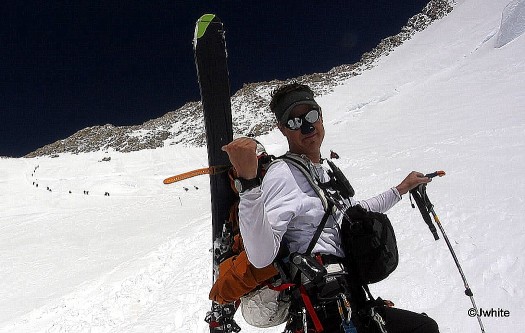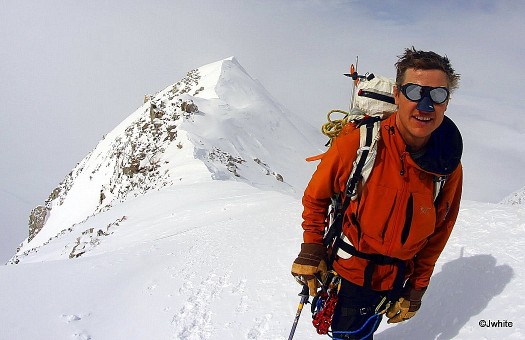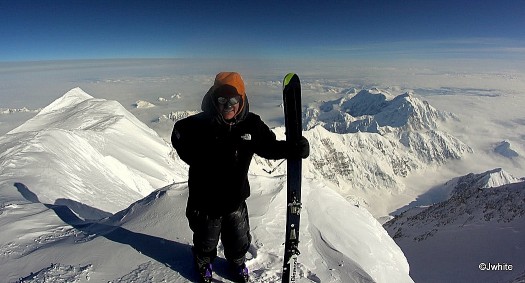I thought Jordan did a great job of detailing his Denali apparel arsenal for readers a few days ago. But people and preferences are different, so for perspective I thought I would share my approach on the subject. This being my second trip on Denali I definitely felt more confident and focused as I set about the task of planning my clothing. Keep in mind I am 6’3″ and 175 pounds, probably about average when it comes to body heat production, my hands are above average in warmth, and my feet seem to be slightly colder than average. I also produce far less sweat than most.

Me on a balmy headwall approach. Sporting my OR Radar visor, Patagonia Capilene 1 sun shirt, and a pack load of enthusiasm for joining the Denali congo line ahead.
HEAD WEAR:
When the mercury was rising or the blood was pumping, I sported my Outdoor Research Radar Visor. I use visors because they breathe exceptionally well while preventing the mid-day sun from damaging my youthful face (grin). That said, when temps dipped or wind swirled, I reached for the High Llama Hat, a terrific mid-weight beanie. Sitting around camp and during summit day I had to put on my bright orange Black Diamond Icon Beanie.
My preferred windchill management method is to use a facemask and my jacket hood, since this is more easily adjusted on the fly than a balaclava. So I carried the Seirus Comfort Masque as a quickdraw frostbite defense. I generally don’t like balaclavas because of overheating and claustrophobia issues. I didn’t carry a heavy balaclava at all this trip and rarely do I on any trip. However Denali is one of the locales that can offer up weather that leaves one no other solution but a balaclava. So with good wind resistance and moisture wicking abilities and at just under 2 ounces, the lightweight OR Option balaclava made the trip. Luckily reasonable conditions during our move days kept the Option in my pack.
Lastly, I kept a standard bandana in my back pocket for sweat management and to place under my hat when the sun really hammered down on my neck and ears. And finally my mountain necklace, a piece of 1mm cord with lip balm and a lighter attached. I keep these two items and my Leatherman Skeletool on my person at all times up there.
EYE WEAR:
I wore a pair of Julbo Dolgan sunglasses with the Spectron 4 polycarbonate lenses on the lower glacier. They are lighter and collect less sweat than my Julbo Explorer glacier glasses, which I used at 14k and above. I added Beko nose guards to both pairs of glasses to fight the relentless UV on the Kahiltna.
My goggle selection was the Smith Phenom frame and Red Mirror lens. I also carried a Sensor Mirror replacement lens in my goggle case for really low light conditions. The Sensor transmits about twice as much visible light as the Red Mirror.
TORSO WEAR:
On the lower glacier, and headwall bakefests, I wore a white Patagonia Capilene 1 Crew Long Sleeve shirt. It was light, sun reflective, and kept me cool. It did harbor terrible smells after extended wear, so I tried to limit use of the layer to only the hot sunny days and took it off as soon as I got into camp. I really prefer a dedicated shirt for those inevitable bake-a-thons though.
For most other conditions, I wore a lightweight wool t-shirt of unknown origin, but it has been with me for a while and works well. Odor management is a thoughtful component of the apparel selection process that my tent mates always appreciate, so I went wool next to the skin. My next layer was the Arc’teryx RHO LTW Zip Top wool shirt. This product is superb. I have been wearing it all winter and shows very little wear. Some folks throw in a lightweight wool layer between the t-shirt and their midweight RHO type layer, but I find it unnecessary personally. The chest pocket on the RHO also happens to be a great place to store an Ipod.
The next layer for me was the Patagonia R1 Pullover. I’ve found that the Polartec fleece garments are ideal for expedition weight insulating layers used around camp or as outer layers on really cold windless days doing camp chores or on the skin track.
Most days my go to torso combination was the Arc’teryx Gamma MX Hoodie over my RHO layer or R1 and RHO layers when the temperature dipped. Plenty of niceties have been said about the Gamma MX and it appears they have sold truck loads of them, rightly so. I wore this layer more than any other outer layer this trip. Hell, I wore it from 14k to the summit. If you are in the market for a soft-shell top this is a winner. I suggest getting the hoodie version, as the hood makes it more versatile as an all around outer layer.

On the ridge to 17,000 feet wearing my Arc'teryx Gamma MX soft-shell, MH Synchro pants, leather gloves, and Julbo Explorer glasses with the Beko nose guard.
I packed my Patagonia Grade VI hard-shell as a lightweight (13oz) waterproof layer. Unfortunately they don’t make this jacket anymore, but the Stretch Ascent and M10 jackets are comparable. Many folks take a more robust waterproof jacket up there and use it as much for warmth as waterproofness (as I did on my first trip). The fact is that though fabrics have come a long way, hard-shells still don’t breathe well when compared to non-waterproof layers. Since Denali is sometimes very snowy but rarely very wet, I wore my soft-shell primarily and thus allocated less weight to the hard-shell category. If caught in wet windy weather, I planned to throw my Grade VI over my Gamma MX soft-shell and tough it out.
Last but not least the big gun, The North Face Himalayan Parka. A sleeping bag for your core. Given that we had relatively warm temps for Denali, chose not to establish a 17k camp, and tried not to move in severe weather, my parka didn’t see much action until the summit. I have been testing the parka all winter though and I truly think it is the best expedition parka on the market right now, hands down better than the other big parkas I own and have used. On the summit ridge we finally got a healthy dose of the windward side of the mountain and, had I not had my Himalayan, I would likely have been in trouble very quickly. As it happened, carrying the 2lbs 11oz parka up the mountain allowed me to sit back and enjoy 30 minutes of photos and celebration in relative comfort.
HAND WEAR:
Thankfully I have naturally warm hands, so I tend to spend most of my time in camp and on the move in my liner gloves. On long trips, I usually carry two pairs of liner gloves for the inevitable lost, burned, ripped, or soaked glove. This trip I took the Manzella Sprint liner glove and the slightly heavier Mountain Hardwear Power Stretch glove. The Sprints became my around camp glove and the Power Stretch did more of its work on the trail. Both were durable, making it through the whole trip intact.
For rope, camp construction, ski, and other heavier work activities I used my Wells Lamont Cowhide work gloves, heavily treated with Nikwax, and with a loop of accessory cord added to each so they could be attached to my harness when not in use. Some folks argue that leather gloves, even treated with waterproofing agents, will get wet and are very hard to dry up there. This argument has merit, but in a cold environment, and with a reasonable amount of forethought, the likelihood of getting the gloves to the soaked point is minimal. With that said, the few times on past trips I have gotten my leathers to the soaked point were when building snow caves or doing other heavy shoveling type work. I have often thought of bringing a pair of waterproof gloves specifically for these types of activities. And by “waterproof”, I am talking about rubber or neoprene not the many waterproof/breathable options available from most outdoor gear manufacturers, they generally don’t do much better than the leathers during serious snow moving sessions.
I used the leathers quite a bit, sometimes wearing the liner gloves in combination for extra warmth. I also made sure to thoroughly dry my gloves whenever the opportunity presented itself. When the mercury really plummeted though, I whipped out my Marmot Expedition mitts. Fortunately, this was only necessary on the summit, but wow did they do the trick. This was one of the gear items that made it on both of my Denali trips, and if there is another it will go on that one too I suspect.
The last couple of hand related items were a pair of midweight gloves, the OR Grippers, basically just a backup that I never had to use. And my Suunto X6HR watch. Not everyone carried a watch, but for estimating team travel times, setting and maintaining a steady pace, staying on schedule, and acquiring navigational reference altitudes, it was indispensable. Indeed, I’ll come out and say that every person on a Denali expedition should carry a good altimeter watch and learn how to operate important settings. (Tip from Lou, who forgot his watch but wished he’d brought it: ‘If you don’t like how a wrist watch gets caught on things and works with gloves, just buckle your Suunto to your pack strap in a position where you can look down and see it whenever the mood hits you.’)
LEG WEAR:
For me, the best solution for covering my nether regions during such a long expedition was a pair of synthetic board shorts like the Patagonia Wavefarers. They worked better than synthetic underwear, they are easier to wash in the field (I thought about using the cook pots for this, but decided my teammates might not approve), held less stench, and were more durable. This layer stayed on the entire trip and desperately needed a wash upon return.
Next up were my Ibex Zepher wool bottoms. Again merino wool is super comfortable and tends to stay free of serious odor buildup. As with my torso layering system, I used a midweight as my first layer instead of a lightweight wool bottom. I have learned that my body has a relatively large temperature range in which it can comfortably operate for a given layering system, and again I don’t produce a lot of sweat so I can get away with skipping a lightweight layer.
I took my Mountain Hardwear Power Stretch bottoms for really cold days. I have used this layer on both my Denali trips and many times in between. It has a great fit, is durable, and keeps me toasty. I only donned this layer on summit day this trip (combined with my Ibex bottoms). It was used more on my first trip, which was a colder one.
My Mountain Hardwear Synchro soft-shell pants were worn most days on the mountain. This is my favorite cold weather soft-shell pant with it’s full length side zips, comfy fleece lining, leg bottoms that work with ski boots, and reinforced material around the infamous crampon zone. Of course it appears that like many great clothing selections it has been discontinued as fast as it was introduced. This drives me nuts.
The Synchro soft-shells saw action everyday on the mountain with the exception of one acclimation trip to 17k and summit day. For the serious cold and potential blowing snow days I like a lightweight, but burly waterproof bib. And like about 60% of the other people up there this year, I went with the Arc’teryx Alpha SV bib. For the weight it’s the best thing out there. Durable, lots of pockets, integrated knee pads, 3/4 side zips, a crotch zip, and a great fit for a tall skinny guy. My only quip was that the Alpha SV doesn’t have an integrated gaiter system. They do have a clip that attached to my ski buckle and seemed to hold things in place, but a lightweight but effective built-in gaiter would be nice. Perhaps Arc’ could take a hint from pants such as the OR Tremor, and put in a minimalist gaiter that zips out for those who don’t want it.
My final leg defense was a pair of Western Mountaineering down pants. At just 10 ounces these puffy wonders provided a copious amount of insulation while still packing down to nearly nothing. They have the essential feature of full side zips for easy on and off, even when under a pair of bibs. I ended up only wearing my down pants while sitting around camp in the evenings and on the summit, but the peace of mind from having them along allowed me to leave other layers at home.

On the summit in full cold weather combat gear. TNF Himalayan parka, WM Flight down pants, Marmot Expedition mitts, and Forty Below Purple Haze overboots. Bring on the cold!
FEET:
I started with a pair of SmartWool Hiking Liner socks, next up were my GatorGear Icelander vapor barrier liners, and then finally a pair of SmartWool PhD Medium Ski socks. I carried an extra pair each of the liner and medium ski socks, which acted as a backup and ended up being a fresh setup for summit day. The system was a little much down low on the glacier, but my ski boots were molded to the system so to prevent blistering and get adequate performance from my sized up ski boots, I elected to keep the sock system static throughout the trip. The VBLs worked so well that my ski socks never got wet or odorous, however the same can’t be said for the liner socks and the insides of my VBLs. To avoid the onset of trench foot I did my best to get my ski boots and wet socks off as soon as the day’s work was complete.
Once the socks were off and the foot powder applied, I threw on my GatorGear Fleece socks (discontinued) and Parbat High Mountaineering Insulated booties. The fleece socks allowed my feet to breathe freely, while keeping them warm and not promoting sweat buildup. I usually slept in the fleece socks. The Parbat Booties are no longer produced unfortunately. They are the best I have ever seen for really cold weather trips, so someone please start making these things again.
Finally my Forty Below Purple Haze overboots were used on summit day and with my Parbat booties inside many days around camp. Like most everyone, I have nothing but praise for my Forty Belows and am anxious to see some of the stuff they are working on now come to market.
WHAT WORKED, WHAT DIDN’T?
Overall I was pleased with my choices. I used almost everything I carried at one point or another. Though a few things didn’t see any action just because conditions were generally better than the worst Denali can offer up.
As for items that I didn’t bring, but seem appealing in hind sight, two things come to mind. Tyler, and a few other folks up there, carried a light weight synthetic insulating layer for around camp and during on-the-trail rest stops. The 13 ounce MontBell Ultralight Thermawrap Parka fit the bill for many and after some thought it would have incorporated into my system well.
Remarkably I only had two garment blowouts, lucky. I have over 100 days on my MH Synchro soft-shell pants in the last year and they have been bulletproof, of course that was until I broke the crotch zipper on the last day on the Kahiltna during routine business at the privy. Definitely gonna repair this and not replace it since the model is discontinued. And, what would a long expedition be without the thoughtless screw-up? Well one of mine was wearing my Western Mountaineering Flight down pants as an outer layer with crampons, the result, two quick holes on each calf. I’ll be repairing this idiot work as soon as I get back home.
WildSnow guest blogger Caleb Wray is a photographer and outdoor adventurer who lives in Colorado and travels worldwide. He enjoys everything from backcountry skiing to surfing.
